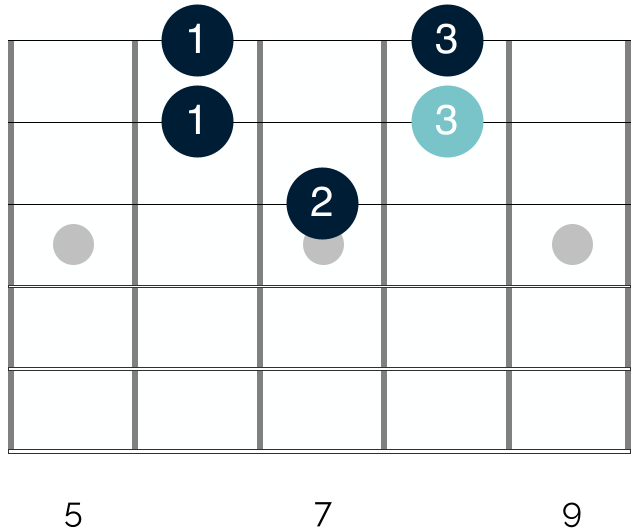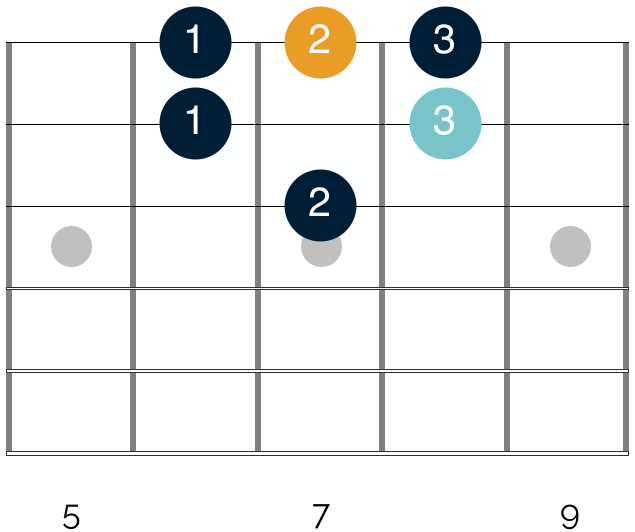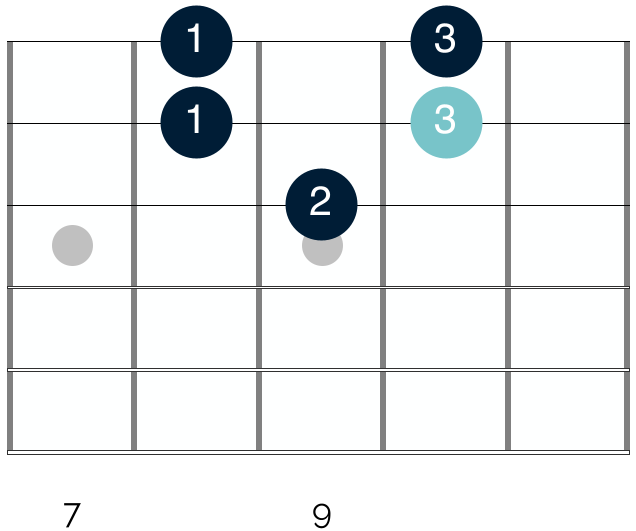When it comes to string bending, there is no blues guitarist more notable than Albert King.
King approached string bending unlike any guitarist before him. In doing so, he crafted a bending style that is still celebrated and studied to this day.
In my opinion, King’s bending style is so distinctive for two reasons.
The first of these is that he uses big bends in his solos.
King regularly includes bends that span a tone and a half or two tones in his solos. And this adds a characteristic intensity and aggression to his lead guitar playing.
In addition, King often stacks bends together in his solos. He plays a variety of different bends together in quick succession.
In doing so, he is able to move fluidly between notes and create a range of different feels, all whilst sticking within a small section of the fretboard.
In this week’s quick win lesson, we will look at how you can utilise these same ideas in your solos.
Specifically, we will look at how adding an extra note into the Albert King Box can help you stack bends together, and recreate the lead sound of both Albert King and Stevie Ray Vaughan.
So with that in mind, let’s get into it.
Here is how you can stack bends together and get more mileage from the Albert King Box:
The Albert King Box
Before we think about adding notes into the Albert King Box, I think it is first important to cover or recap the original box shape.
Luckily, this is nice and straightforward.
The Albert King Box is not a new scale or box shape. In fact it is just a collection of 5 notes that are taken directly from the top strings of the second minor pentatonic scale shape.
In the key of G, this is what the Albert King Box looks like:

This shows the suggested fingering for the Albert King Box, and highlighted in light blue is the tonic note of G.
The benefit of this box shape is that it allows you to execute a variety of different bends within a compact area of the fretboard.
I discuss the many different bending options available in the box in a lesson on multiple pitch bending, which you can find here.
In short though, you can target the 6th frets on both the B and E strings, and the 8th fret on the E string with bends. In each case you can choose to either bend up a semitone (a single fret) or a tone (two frets).
The type of bend you choose will create a particular feel, depending on the note that you hit with your bend.
For example, if you bend the 6th fret on the E string up a semitone, you will hit a note outside of the minor pentatonic or minor blues scales.
Specifically, you will hit a note from the G major pentatonic scale (more on this below). If you bend up a full tone then you will hit the note from the minor pentatonic scale at the 8th fret on the E string.
This is just one example. However hopefully it helps to illustrate the potential for bending inside the Albert King Box.
Once you have hit these notes with different bends, you then have two very effective options for resolving your phrases. You can either play the 8th fret on the B string, or the 7th fret on the G string.
The former is the tonic note (in this case the note of G), and the latter the perfect fifth interval. Both of these notes create a strong sense of resolution and will help to bring your phrases to an effective conclusion.
Mixing major & minor
The Albert King Box only contains notes from the minor pentatonic scale. However as noted above, you can also target notes from different scales (like the major pentatonic and blues scales), depending on the bends you use in your playing.
We can take this one step further by adding an extra note from the major pentatonic scale into the box, as follows:

The note highlighted in yellow here shows the additional note from the G major pentatonic scale. As noted above, if you target the 6th fret on the E string with a semitone bend you will hit this note.
So if you have used the Albert King Box with any frequency, it is likely that you have already targeted this note in your playing.
However by adding the note into the box as an additional note you play, you can target this sound with greater frequency. You can also create different feels by bending from this note.
For example, if you bend the note a semitone you will move up to the 8th fret on the E string with your bend.
Conversely, if you push the bend up a whole tone you will hit the blue note that appears at the 9th fret on the same string.
Bend stacking
When you add this extra note into the Albert King Box, you end up with 3 notes next to each other on the same string.
You can bend all of these notes. And you can do so with a variety of bends, each of which will create a different feel in your solo.
You can also stack these bends together and play them in ascending or descending order. Doing so allows you to target a wide range of notes through bending, and to do so in quick succession.
I illustrate this shortly after the 20 second mark in the video above. When executed in this way, bend stacking creates a cascading sound that works very well as a mechanism of building tension and a sense of momentum in your solos.
Stevie Ray Vaughan executes this idea brilliantly in the main solo in Texas Flood. The solo starts around the 2.40 minute mark. And at around the 3.15 minute mark, Vaughan plays the following idea:

Vaughan plays the original song with his guitar tuned down to E flat, but uses the G minor and major pentatonic scales.
In this way he plays the Albert King Box in the same section of the fretboard we have been discussing up to this point.
As such, for continuity I have altered the audio to be in standard tuning, which you can hear on the following clip:
As you can see and hear in the second bar of this clip, Vaughan uses the exact idea we have been covering up to this point.
He starts on the 6th fret of the E string and targets the note with two different bends. He then moves to the 7th fret – and again plays a variety of different bends – before moving up to the 8th fret.
It is around this section of the solo that the vibe and intensity of the Vaughan’s playing increases. And this bend stacking idea is vital in helping Vaughan build momentum into the second, more intense half of the solo.
How to use bend stacking
If you want to start targeting this idea in your solos, there are two different elements that you need to consider and consolidate. The first of these is how to use the idea in your solos. The second is when it is appropriate to use in your solos.
Let’s look at each of these in turn:
To begin with, it is important to get comfortable with the mechanics and theory behind the idea. Thankfully this is not too complicated. There are however a few key points to keep in mind to use the box shape effectively.
These are as follows:
Firstly and significantly, you can use the Albert King Box in any key. The examples in this lesson have been in the key of G.
However the Albert King Box is a moveable box shape that you can play all over the fretboard.
In the key of A for example, the Albert King Box is as follows:

As you can hopefully see, the shape and fingerings in the key of A are exactly the same as in the key of G. The only difference is that now the box shape appears two frets higher.
Appreciating this point will help you to start using the box regularly and with confidence in a range of keys. When you do so, it is also important to remember the following:
- The Albert King Box just contains notes from the minor pentatonic scale. As such, you can also use it when soloing in both a minor and major blues context
- When you add in the new note from the major pentatonic scale we have been discussing in this lesson, do so in a major blues context. This will prevent any unwanted clashes that might occur when you are playing notes of the major pentatonic scale over minor chords
- Not all of the notes in the Albert King Box can be bent. If you bend the tonic note and the perfect 5th interval (the 7th fret on the G string and the 8th fret on the B string in the key of G) you risk creating some tense and unsettled sounding bends
Appreciating these points will ensure that you use the box shape effectively, maximise its potential, and avoid any unwanted tension or dissonant clashes when playing.
Once you are in this position, you can then start to think about when to implement this specific bend stacking idea.
When to use bend stacking
In my opinion, there is almost no limit to the frequency that you can use the Albert King Box.
In essence, it is just a collection of notes from the minor pentatonic scale which are particularly well suited to bending.
King uses the box in almost all of his solos, and Stevie Ray Vaughan also uses it with great frequency.
In fact, most of Vaughan’s lead playing in Texas Flood is focused around the box shape, in addition to the first shape of the minor pentatonic scale.
There is however a significant difference between using the Albert King Box, and using bend stacking within the box.
The Albert King Box is very versatile. When playing in this box shape, you can create a range of different feels through your dynamics, pick attack and bending style.
The same is not true of bend stacking. Bend stacking creates a very particular feel in your playing. It has quite an intense feel, which is perfect for building momentum in your solos and creating tension.
Not only this, but it requires a certain amount of time to execute.
You have to bend at least three notes in succession. And to get the most out of the technique, it is likely that you will bend each individual note more than once.
As such, I would recommend using bend stacking more sparingly.
In my opinion it is an idea that you can execute once per solo. In this way, you can pick a single moment where you want to build momentum and alter the vibe of your solo.
You can see Stevie Ray Vaughan take this approach in Texas Flood.
In the first half of the solo he plays extensively using the Albert King Box. He does utilise bend stacking, but only very briefly.
In the section tabbed out above however, he uses bend stacking extensively to add intensity and bite to his solo. The second half of the solo then takes on an altogether more intense vibe, with multiple string bends and fast licks.
Closing thoughts
In my opinion we can group techniques and concepts into two broad categories. There are those which are fundamental to the blues and which should always be present in your playing.
Examples of this are vibrato and bending.
There are of course many different ways you can execute both techniques. In general though, you should be focusing on both of them as a way of breathing life and expression into your playing.
Conversely, there are techniques that you can view as tools to perform a specific job.
These techniques are often derived from the fundamentals. However they have such a distinct sound that they are unlikely to be continually present in your playing.
Examples of this are trills and unison bends. Both techniques perform the specific role of creating an intense and aggressive sound in your playing.
You have to approach this second category of technique carefully in your solos.
Their scope is more limited. And if you start to use them with great frequency, the quality of your solos will suffer. They will sound repetitive, and these techniques – which are so effective when used sparingly – will start to lose their impact.
Bend stacking falls within this category.
As noted throughout, bend stacking will help you to build momentum in your solos. It will also create a distinct Albert King and Stevie Ray Vaughan vibe in your playing. But you can quickly overuse the technique, so be conscious of this when using it in your solos.
Otherwise, good luck trying this out!
Let me know how you get on, and if you have any questions, just send them across. You can reach me on your messenger whenever and I am always around and happy to help 😁
